Vehicular camera and lens assembly
a technology of lens assembly and camera body, which is applied in the field of vehicle cameras, can solve the problems of relative cost of components, and achieve the effect of cured relatively quickly
- Summary
- Abstract
- Description
- Claims
- Application Information
AI Technical Summary
Benefits of technology
Problems solved by technology
Method used
Image
Examples
embodiment 1
Use of UV-Curable Adhesive to Mount Lens to Holder
[0034]FIG. 1 shows an exploded view of a vehicular camera 10 in accordance with a first embodiment of the invention. The vehicular camera 10 includes an imager 20, a lens holder such as a front camera housing 14 and a lens 16. The vehicular camera 10 may include other components such as additional circuitry for processing the video input received by the imager 20, e.g., circuitry for providing graphic overlay to the video input. The vehicular camera 10 may further be configured to transmit the video input to other vehicular devices, such as a display controller (not shown) for a cabin-mounted display (not shown).
[0035]The imager 20 may be a charge-coupled device (CCD) or a complimentary metal-oxide semiconductor (CMOS) sensor. Referring additionally to FIG. 2, the imager 20 is mounted to a printed circuit board (PCB) 12. The imager 20 is positioned to receive optical images from the lens 16. In the exemplary embodiment shown in FIG. ...
embodiment 2
Integration of Lens Barrel and Camera Lens Holder
[0047]FIG. 5 shows another embodiment 110 of a vehicular camera, wherein the lens barrel 114 housing the optical components of the lens 112 and the camera front housing 130 form a single integrated piece 150. The lens optical elements 120, O-rings and spacers 122, 124 and IR cutoff filter 126 (FIG. 4) are placed inside a lens barrel portion 114′ of the integrated lens barrel and camera upper housing piece 150 as part of the conventional lens assembly process to provide a lens 112′ (FIG. 5). The integrated piece 150 can be formed by plastic injection molding or metal machining. Plastic injection molding is preferred for lower cost and ease of attaching the back housing 132 to the integrated piece 150 by gluing, laser or ultrasonic welding.
[0048]The PCB 138 with imager 140 is mounted to the integrated piece 110. Lens 112′ is focused relative to the imager 140 by applying techniques described in embodiments 3 to 6.
[0049]The advantages of...
embodiment 3
Lens Barrel Dropped on Surface of Imager
[0050]FIG. 6 shows another embodiment 200 of a vehicular camera wherein the lens barrel 114′ of the integrated piece 150 is dropped onto and sits directly on top of the surface of the imager 140. During the camera assembly process, the lens barrel 114′ is dropped directly onto the imager 140 as shown in FIG. 6. The lens barrel 114′ includes a special designed mechanical feature such as rebate 202 (see detail view of FIG. 6A) so that, while the lens barrel 114′ is dropped to onto the imager 140, the rebate 202 guides the lens 112′ to have proper horizontal alignment such that the lens optical axis is in line with the center of the imager sensing area.
[0051](The alignment of optics axis to the center of the imager can also be achieved by digital shifting of image sensing window on imager. This digital center shifting feature can be found in some imagers, e.g. Aptina MT9V 126 CMOS imager.)
[0052]As shown in FIG. 6, the lens 112′ can be secured by ...
PUM
| Property | Measurement | Unit |
|---|---|---|
| temperature | aaaaa | aaaaa |
| humidity | aaaaa | aaaaa |
| time | aaaaa | aaaaa |
Abstract
Description
Claims
Application Information
 Login to View More
Login to View More - R&D
- Intellectual Property
- Life Sciences
- Materials
- Tech Scout
- Unparalleled Data Quality
- Higher Quality Content
- 60% Fewer Hallucinations
Browse by: Latest US Patents, China's latest patents, Technical Efficacy Thesaurus, Application Domain, Technology Topic, Popular Technical Reports.
© 2025 PatSnap. All rights reserved.Legal|Privacy policy|Modern Slavery Act Transparency Statement|Sitemap|About US| Contact US: help@patsnap.com



